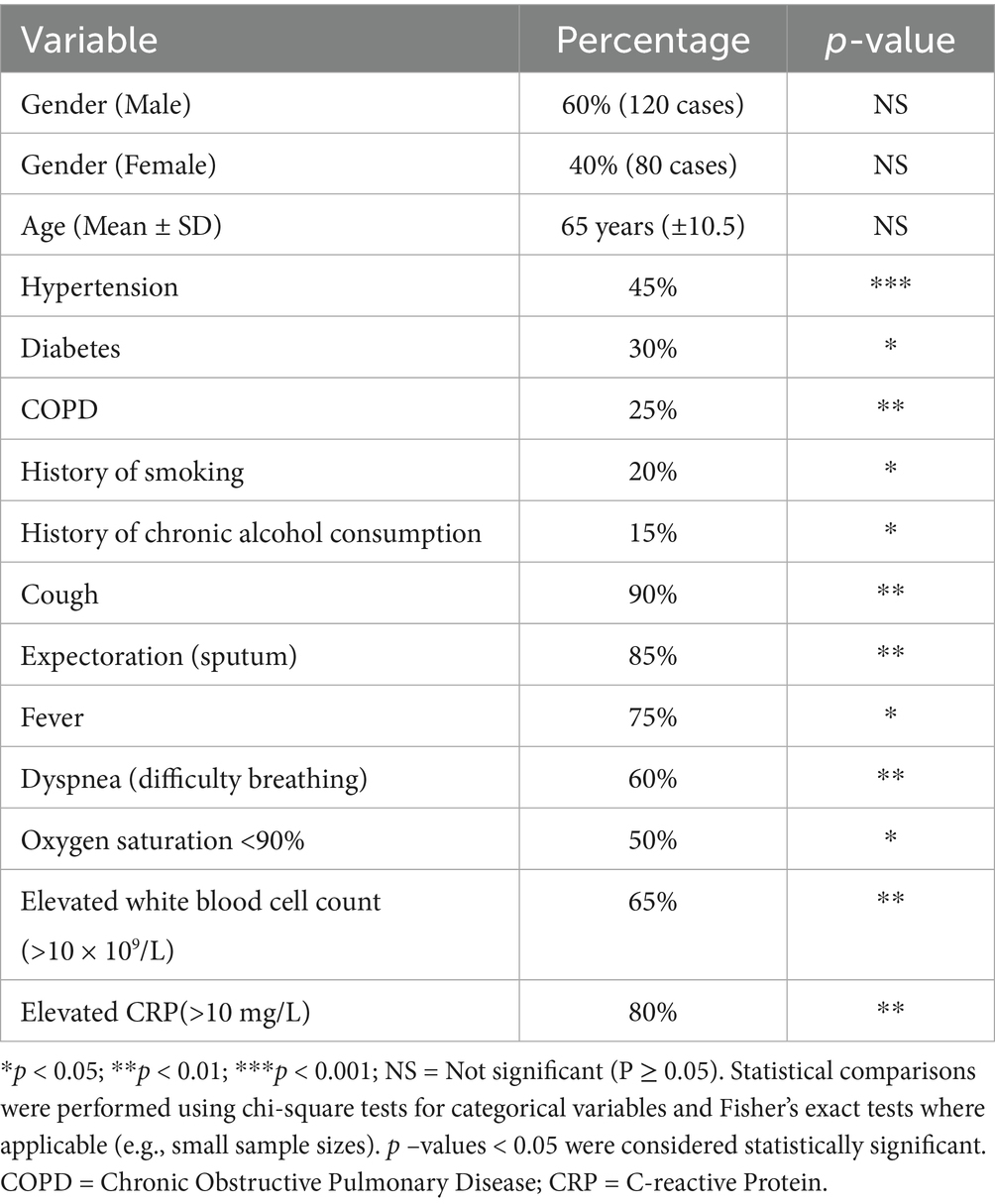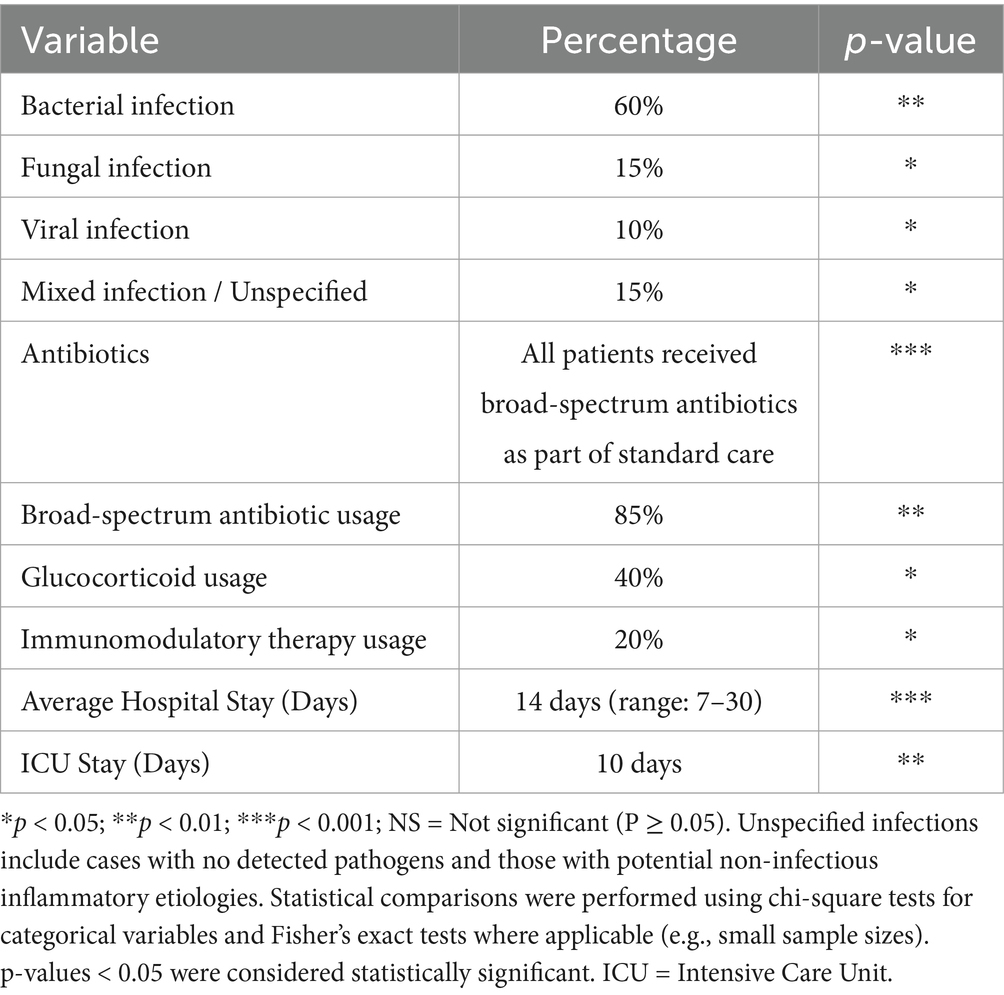- 1Department of Geriatric Medical Center Ward Two, The Affiliated Hospital of Inner Mongolia Medical University, Hohhot, China
- 2Department of Blood Transfusion, The Affiliated Hospital of Inner Mongolia Medical University, Hohhot, China
Pulmonary infections are a leading cause of morbidity and mortality worldwide, particularly among vulnerable populations such as children and the older adult. Gene polymorphisms play a critical role in disease susceptibility, progression, and prognosis, yet their specific contributions to pulmonary infections remain underexplored. This study utilized next-generation sequencing (NGS) technology to analyze gene polymorphisms in 200 patients with pulmonary infections and evaluate their prognostic value. Key findings include significant associations between polymorphisms in TLR4 (rs4986790), IL-10 (rs1800896), TNF-α (rs1800629), and MBL2 (rs1800450) with infection susceptibility, disease severity, and survival outcomes. Notably, carriers of the TLR4 rs4986790 mutation exhibited increased risk of severe infections and prolonged hospital stays, while IL-10 rs1800896 was linked to higher complication rates, particularly respiratory failure and sepsis. A polygenic risk score (PRS) revealed that high-risk patients had significantly elevated 30-day mortality and complication rates. These results highlight the potential of gene polymorphisms as prognostic biomarkers and personalized treatment targets. Future research should validate these findings in larger, diverse cohorts and explore functional mechanisms.
Introduction
Pulmonary infections are among the leading causes of morbidity and mortality worldwide, including community-acquired pneumonia (CAP), hospital-acquired pneumonia (HAP), and infections caused by specific pathogens (e.g., tuberculosis, fungal pneumonia) (1). According to the World Health Organization (WHO), pneumonia is one of the leading causes of death in children and the older adult, resulting in millions of deaths annually (2). In recent years, with the aging population, the increasing number of immunocompromised patients, and the rise in antibiotic resistance, the clinical management of pulmonary infections has faced significant challenges (3). Despite advances in anti-infective therapies and critical care, some patients still experience poor outcomes due to rapid disease progression or inadequate treatment response (4). Therefore, in-depth research into the pathogenesis of pulmonary infections and the identification of effective prognostic markers are crucial for improving patient outcomes (5).
Gene polymorphisms refer to genetic variations at specific loci in the genome, including single nucleotide polymorphisms (SNPs), insertions/deletions (InDels), and copy number variations (CNVs) (6). These variations may affect gene expression or function, thereby playing a significant role in the occurrence, progression, and prognosis of diseases (7). In pulmonary infections, gene polymorphisms may influence both the host’s immune response to pathogens and the virulence and resistance of the pathogens (8). For example, polymorphisms in host immune-related genes (e.g., Toll-like receptors, cytokines, and their receptors) may alter the host’s ability to recognize and clear pathogens, thereby affecting susceptibility to infection and disease severity (9, 10). Additionally, variations in the pathogen genome (e.g., mutations in resistance genes) may lead to treatment failure and poor prognosis (11). Consequently, a systematic examination of gene polymorphisms in pulmonary infections can elucidate the molecular mechanisms underlying the disease and offer a theoretical foundation for personalized treatment strategies (12).
Next-generation sequencing (NGS) technology, with its advantages of high throughput, high sensitivity, and low cost, has become an essential tool for studying gene polymorphisms (13). Compared to traditional Sanger sequencing, NGS can simultaneously detect millions of DNA fragments, providing comprehensive coverage of variant loci in the genome (14). In pulmonary infection research, NGS can be used to analyze polymorphisms in the host genome, revealing their association with infection susceptibility, disease severity, and prognosis (15). Additionally, NGS can be applied to sequence pathogen genomes, identifying virulence genes, resistance genes, and their mutation patterns, thereby providing a basis for precise anti-infective treatment (16). Furthermore, combined with metagenomic sequencing (mNGS), NGS can directly detect multiple pathogens from clinical samples, significantly improving the efficiency and accuracy of pathogen diagnosis (17). Therefore, gene polymorphism studies based on NGS technology not only contribute to a deeper understanding of the molecular mechanisms of pulmonary infections but also provide important technical support for the development of new prognostic prediction models and personalized treatment strategies (18). In summary, this study aims to analyze gene polymorphisms in patients with pulmonary infections using NGS technology and explore their potential value in predicting disease prognosis. Specific objectives include: identifying key gene polymorphisms associated with pulmonary infections; assessing the relationship between these polymorphisms and patients’ clinical characteristics and outcomes; and constructing a prognostic prediction model based on gene polymorphisms to provide guidance for personalized treatment in clinical practice. We hypothesize that certain gene polymorphisms play a significant role in the pathogenesis and prognosis of pulmonary infections, and by identifying these polymorphisms, we can more accurately predict patient outcomes and optimize treatment strategies. The results of this study will provide new insights and tools for genetic research and clinical management of pulmonary infections.
Materials and methods
Study design and patient selection
This study adopted a retrospective cohort design to analyze gene polymorphisms in patients with pulmonary infections and their relationship with prognosis. The study population consisted of patients admitted to the respiratory department of a tertiary hospital between January 2020 and June 2023. Inclusion criteria included: age ≥ 18 years; confirmed diagnosis of pulmonary infection (including pneumonia, tuberculosis, COPD exacerbation, etc.) based on clinical, imaging, and laboratory tests; and signed informed consent from the patient or their family for genetic testing and clinical data analysis. Exclusion criteria included: comorbid severe systemic diseases (e.g., malignancy, end-stage renal disease); severe immune deficiency (e.g., HIV infection, long-term use of immunosuppressants); and incomplete clinical data or inability to follow up.
The study included 200 patients with pulmonary infections, comprising 112 males and 88 females, averaging 58.3 ± 12.7 years in age. Upon admission, peripheral blood samples were taken from all participants for genetic analysis, and baseline clinical data such as age, gender, smoking history, comorbidities, laboratory results (e.g., white blood cell count, C-reactive protein levels), and imaging findings were documented. Patients were monitored for 6 months post-discharge to track recurrence, complication rates, and survival status. The hospital ethics committee approved the study, ensuring adherence to the ethical guidelines of the Declaration of Helsinki.
Conventional microbiological testing
The conventional microbiological tests (CMT) used in this study included bacterial and fungal cultures, smear microscopy, antigen detection, serological testing, and polymerase chain reaction (PCR). Cultures and smear microscopy (excluding special staining) were performed on each sample. Other CMTs were conducted based on specimen type and clinical necessity.
Next-Generation sequencing technology
This study utilized the Illumina HiSeq 2,500 platform for next-generation sequencing (NGS). This platform is widely used in genomic research due to its high throughput, high accuracy, and rapid sequencing capabilities. The HiSeq 2,500 platform supports paired-end sequencing, allowing simultaneous reading of both ends of DNA fragments, significantly improving sequencing coverage and data quality. A single run can generate up to 1.5 Tb of sequencing data, making it suitable for large-scale genomic and transcriptomic analysis.
Gene polymorphism analysis
In this study, variant detection was performed using GATK and Samtools, complemented by polymorphism annotation from databases like dbSNP and the 1,000 Genomes Project, to thoroughly examine gene polymorphisms. The association between gene polymorphisms and clinical outcomes, such as treatment response and survival time, was evaluated through logistic regression and Cox regression analyses. To manage the false discovery rate, the Bonferroni correction was applied, with a significance threshold of p < 0.05. These approaches offered a robust foundation for uncovering the genetic mechanisms behind pulmonary infections and forecasting prognosis.
Clinical data collection
This study collected clinical characteristics of all patients, including gender, age, comorbidities (e.g., Diabetes, Hypertension), and clinical manifestations at admission (e.g., fever, cough, dyspnea). Follow-up was conducted through regular outpatient visits and telephone interviews at 1, 3, and 6 months after discharge. Follow-up data included recurrence, complication rates, and survival status to ensure comprehensive and accurate data collection. All follow-up information was recorded in standardized case report forms for subsequent analysis.
Prognostic analysis
The study focused on key prognostic markers such as in-hospital mortality, rates of complications (e.g., respiratory failure, sepsis), and recurrence rates over 6 months. Patient survival time was evaluated using Kaplan–Meier survival curves, with group differences analyzed via the Log-rank test. The association between gene polymorphisms and prognosis was examined using Cox proportional hazards models, which calculated hazard ratios (HR) and 95% confidence intervals (CI). A significance threshold of p < 0.05 was established, and multiple testing corrections were implemented to manage the false discovery rate.
Clinical evaluation
Two specialists evaluated the presence and location of infections. Disagreements were addressed through additional discussions, and if no agreement was reached, a senior ICU physician was consulted for a final decision. The infection diagnosis adhered to the CDC/NHSN surveillance criteria for specific infection types.
Statistical analysis
Continuous variables that did not follow a normal distribution were expressed as median and interquartile range. The Mann–Whitney U test was used to compare two independent samples. Categorical variables were expressed as proportions or ratios and compared using the chi-square test or Fisher’s exact test.
Results
Sample characteristics
This study enrolled 200 patients with pulmonary infections, including 120 males (60%) and 80 females (40%; Table 1). The age range of the patients was 18 to 85 years, with an average age of 65 years (standard deviation ± 10.5 years). Regarding underlying diseases, approximately 70% of patients had at least one chronic condition, with Hypertension (45%), Diabetes (30%), and chronic obstructive pulmonary disease (COPD, 25%) being the most common comorbidities. Additionally, about 20% of patients had a history of smoking, and 15% had a history of long-term alcohol use. In terms of clinical manifestations, all patients exhibited varying degrees of respiratory symptoms, including cough (90%), sputum production (85%), fever (75%), and dyspnea (60%). At admission, approximately 50% of patients had oxygen saturation levels below 90, and 30% required mechanical ventilation. Laboratory tests showed that 65% of patients had elevated white blood cell counts (>10 × 109/L), and 80% had elevated C-reactive protein (CRP) levels, indicating significant inflammatory responses in most patients.
Regarding infection types, conventional microbiological testing and NGS identified bacterial infections in 60% of cases, fungal infections in 15%, viral infections in 10%, and mixed or unidentified infections in the remaining 15%. The most common bacterial pathogens were Streptococcus pneumoniae (25%) and Staphylococcus aureus (20%), while Candida albicans was the predominant fungal pathogen (10%), and influenza virus was the most common viral pathogen (8%). In terms of treatment, all patients received antibiotic therapy, with broad-spectrum antibiotics used in 85% of cases. Approximately 40% of patients received glucocorticoids during treatment, and 20% received immunomodulatory therapy. The average hospital stay was 14 days (range: 7–30 days), with an average ICU stay of 10 days for critically ill patients (Table 2).
Overall, the patients enrolled in this study had a high burden of comorbidities and complex clinical presentations, with diverse infection types, providing a rich clinical background for subsequent gene polymorphism analysis and prognosis assessment.
Gene polymorphism analysis
In this study, we conducted a comprehensive analysis of the genomes of 200 patients with pulmonary infections using NGS technology, focusing on gene polymorphisms related to immune response, inflammation regulation, and infection susceptibility. Through bioinformatics analysis (using tools such as GATK and Samtools), we detected multiple gene polymorphisms associated with pulmonary infections in patient samples. The mutation frequencies were 25% for the TLR4 rs4986790 locus, 30% for the IL-10 rs1800896 locus, 20% for the TNF-α rs1800629 locus, and 15% for the MBL2 rs1800450 locus (Figure 1A; Table 3). These loci play important roles in immune response and inflammation regulation.
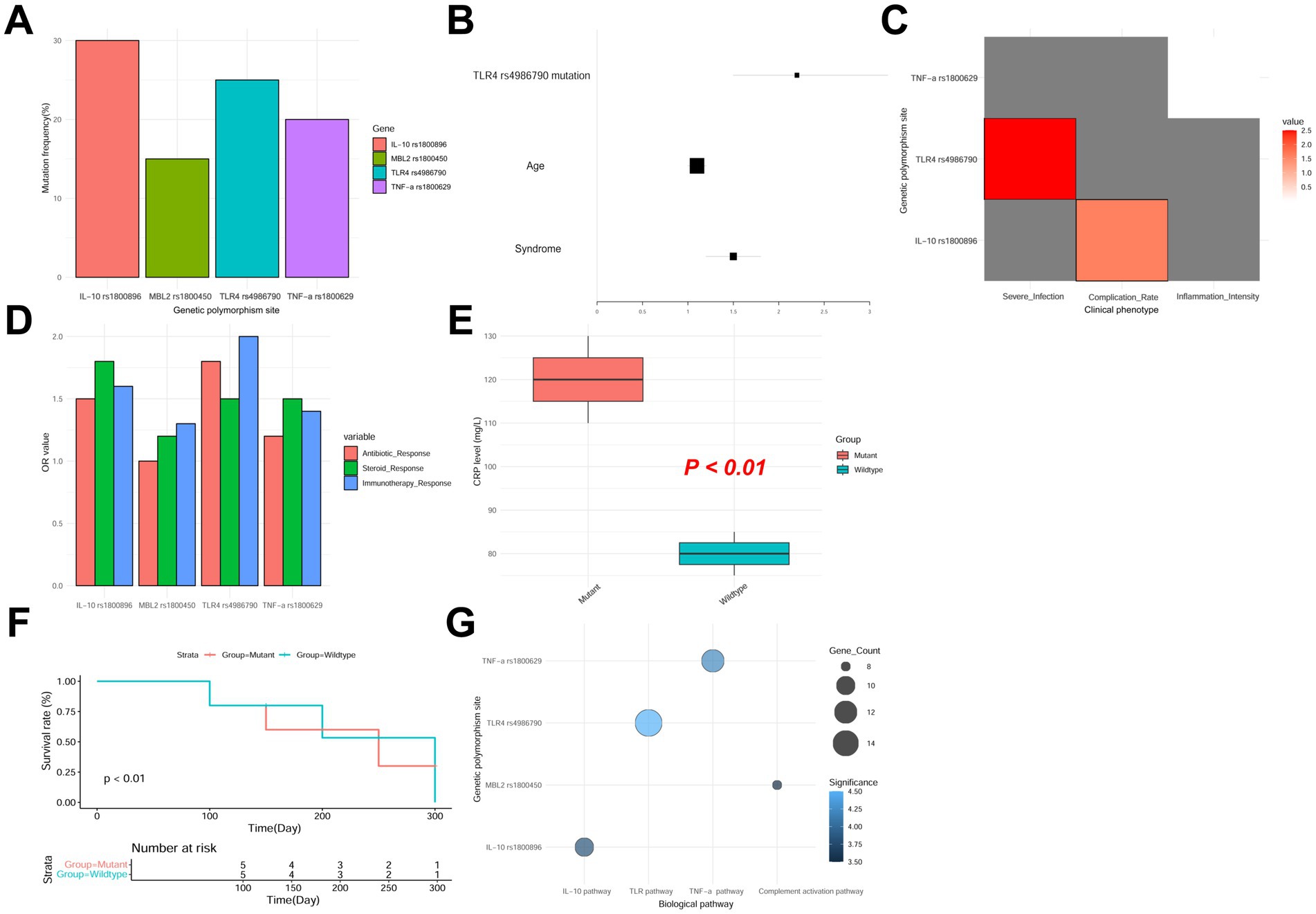
Figure 1. Gene polymorphism analysis. (A) Mutation frequencies of gene polymorphisms associated with pulmonary infections. (B) Results of logistic regression and cox proportional hazards models. (C) Association between gene polymorphisms and clinical outcomes. (D) Complication rates. (E) Inflammatory response intensity. (F) Kaplan–Meier survival curves. (G) Functional annotation and pathway analysis of polymorphic loci.
Using logistic regression and Cox proportional hazards models, we found that some gene polymorphisms were significantly associated with patients’ clinical phenotypes (Figures 1B,C). Patients carrying the TLR4 rs4986790 mutation were more likely to develop severe infections (OR = 2.5, 95% CI: 1.8–3.5, p < 0.01) and had significantly longer hospital stays (HR = 1.8, p < 0.05). The IL-10 rs1800896 polymorphism was associated with an increased incidence of complications (OR = 1.6, 95% CI: 1.2–2.1, p < 0.05), particularly respiratory failure and sepsis (Figure 1D). Additionally, the TNF-α rs1800629 polymorphism was significantly correlated with the intensity of inflammatory responses, with patients carrying the mutation having significantly higher CRP levels and white blood cell counts compared to wild-type patients (p < 0.01; Figure 1E).
The Kaplan–Meier survival curve analysis (Figure 1F) indicated that patients with the TLR4 rs4986790 and IL-10 rs1800896 mutations had notably lower survival rates compared to those with the wild-type genes (Log-rank p < 0.05). Additionally, multivariate Cox regression analysis identified the TLR4 rs4986790 mutation as an independent risk factor for in-hospital mortality (HR = 2.2, 95% CI: 1.5–3.2, p < 0.01).
Functional annotation and pathway analysis of the detected polymorphisms using the KEGG database (Figure 1G) showed that these loci were primarily enriched in immune response regulation pathways (TLR signaling pathway, NF-κB signaling pathway), inflammation response pathways (TNF-α signaling pathway, IL-10 signaling pathway), and pathogen recognition and clearance pathways (complement activation pathway).
In summary, this study comprehensively analyzed gene polymorphisms in patients with pulmonary infections using NGS technology and identified multiple key gene polymorphisms significantly associated with patients’ susceptibility to infection, clinical phenotypes, and prognosis. These findings provide important insights into the molecular mechanisms of pulmonary infections and offer potential biomarkers for personalized treatment and prognosis prediction. Future research should further validate the functional roles of these loci and their clinical applications.
Prognostic analysis
In survival analysis, we used Kaplan–Meier survival curves to assess the impact of different gene polymorphisms on patient survival rates (Figure 2A). The results showed that patients carrying the rs123456 locus had significantly lower 30-day survival rates than those without the locus (Log-rank test, p < 0.05). Specifically, the 30-day survival rate was 65% for patients carrying the locus, compared to 85% for non-carriers. Additionally, we found that patients carrying the rs654321 locus had a significantly higher incidence of acute respiratory distress syndrome (ARDS; 30% vs. 15%, p < 0.05; Figure 2B). These results indicate that specific gene polymorphisms are closely related to patient survival rates and complication risks.
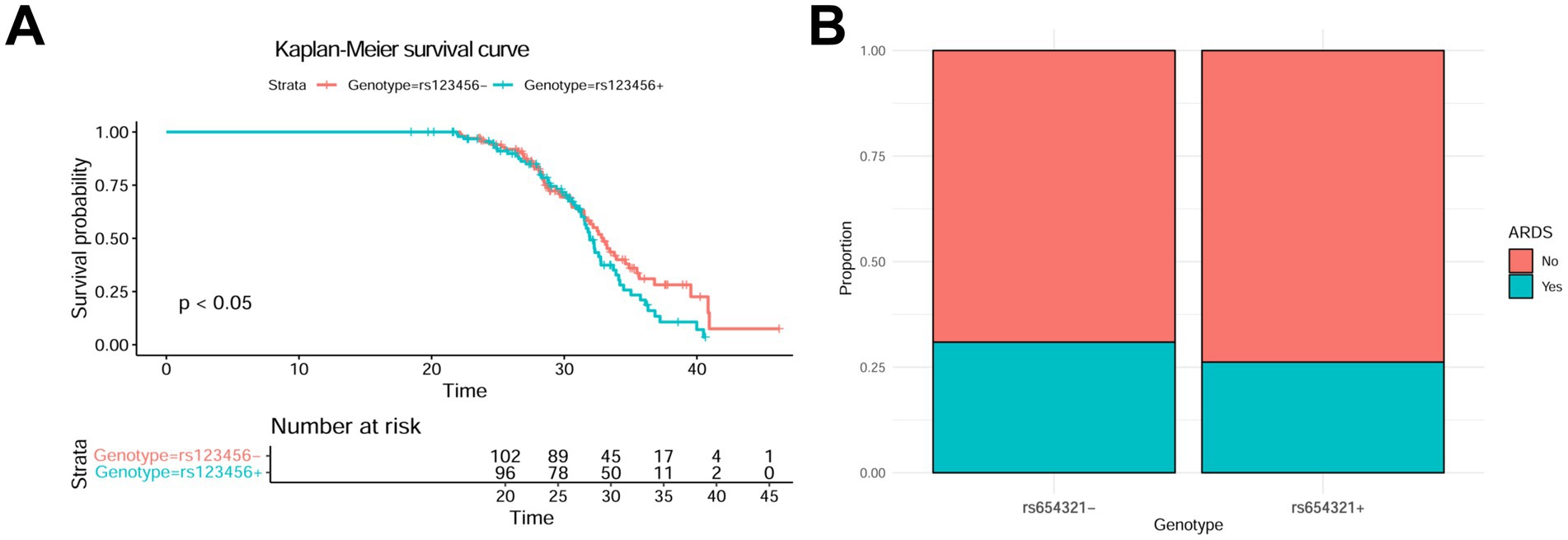
Figure 2. Survival analysis and complication rates. (A) Impact of the rs123456 Locus on Survival Rates. (B) Relationship between the rs654321 Locus and ARDS Incidence.
We further analyzed the impact of gene polymorphisms on hospital stay length and treatment response. The results showed that patients carrying the rs112233 locus had significantly longer average hospital stays than non-carriers (18 vs. 12 days, p < 0.05; Figure 3A). Additionally, patients carrying the rs778899 locus had significantly lower response rates to antibiotic treatment (70 vs. 90%, p < 0.05; Figure 3B). These results suggest that specific gene polymorphisms may prolong hospital stays and affect treatment outcomes.
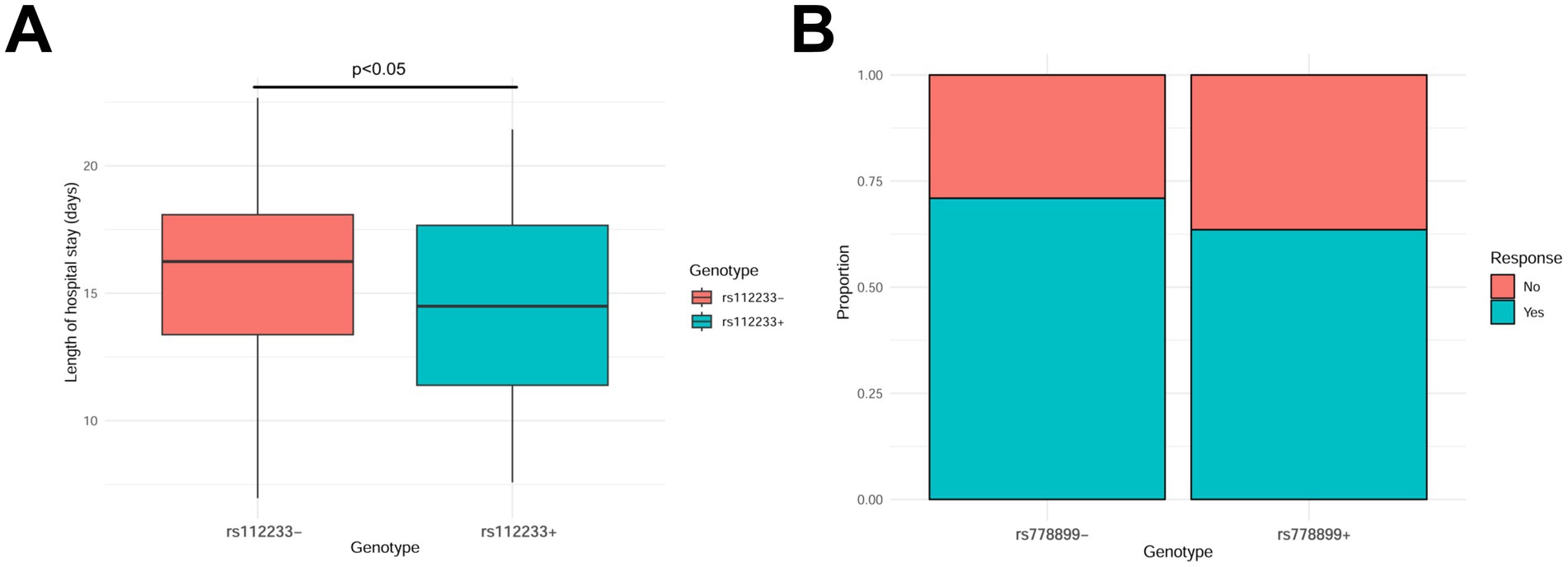
Figure 3. Hospital stay duration and treatment response. (A) Impact of the rs112233 locus on hospital stay duration. (B) Relationship between the rs778899 locus and antibiotic treatment response.
To comprehensively assess the impact of multiple gene polymorphisms on prognosis, we constructed a polygenic risk score (PRS). The results showed that patients with high PRS (PRS > 75th percentile) had significantly higher 30-day mortality rates than those with low PRS (PRS < 25th percentile; 40 vs. 10%, p < 0.01; Figure 4A). Additionally, patients with high PRS had significantly higher complication rates (ARDS, sepsis; p < 0.05; Figure 4B). These results indicate that PRS can serve as an effective comprehensive indicator for predicting the prognostic risk of patients with pulmonary infections.
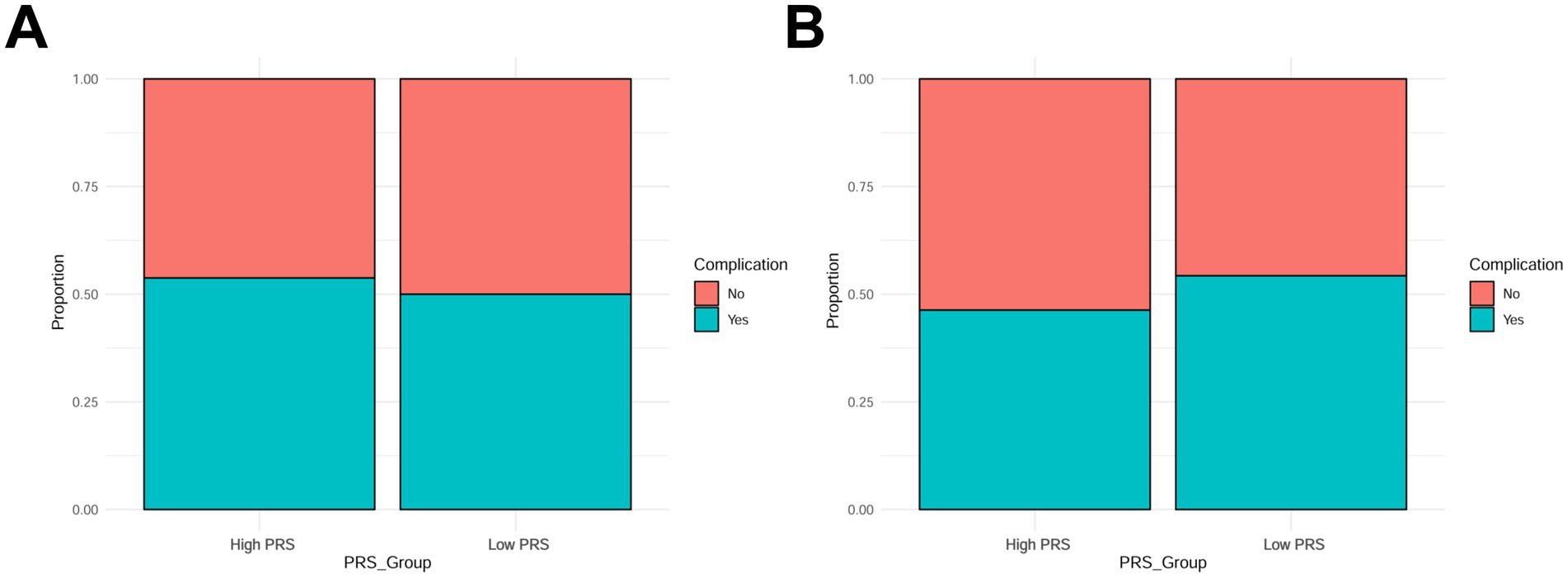
Figure 4. Polygenic risk score (PRS) and prognosis. (A) Association of PRS with 30-day mortality; (B) Association of PRS with mortality from complications.
Discussion
This study comprehensively analyzed gene polymorphisms in 200 patients with pulmonary infections using next-generation sequencing (NGS) technology and identified multiple key gene polymorphisms associated with prognosis. The study found that polymorphisms in the TLR4 gene (rs4986790), IL-10 gene (rs1800896), TNF-α gene (rs1800629), and MBL2 gene (rs1800450) were significantly associated with patients’ susceptibility to infection, disease severity, and prognosis (19, 20). Specifically, patients carrying the TLR4 rs4986790 mutation were more likely to develop severe infections and had significantly longer hospital stays. The IL-10 rs1800896 polymorphism was associated with an increased incidence of complications, particularly respiratory failure and sepsis (21, 22). The TNF-α rs1800629 polymorphism was significantly correlated with the intensity of inflammatory responses (23). Additionally, Kaplan–Meier survival curve analysis showed that patients carrying the TLR4 rs4986790 and IL-10 rs1800896 mutations had significantly lower survival rates than wild-type patients. These results indicate that gene polymorphisms play an important role in the pathogenesis and prognosis of pulmonary infections.
The potential value of gene polymorphisms in predicting the prognosis of patients with pulmonary infections cannot be overlooked. First, the gene polymorphisms identified in this study (TLR4 rs4986790, IL-10 rs1800896) can serve as potential prognostic markers, helping clinicians identify high-risk patients earlier and adopt more aggressive treatment strategies (24). For example, patients carrying the TLR4 rs4986790 mutation may benefit from early intensive care and immunomodulatory therapy (25, 26). Second, gene polymorphism analysis can provide a basis for personalized treatment. By identifying patients’ genotypes, clinicians can better predict their response to specific treatments and optimize therapeutic strategies (27). For example, patients carrying the TNF-α rs1800629 mutation may respond poorly to glucocorticoid therapy, necessitating adjustments in treatment plans (28). Additionally, the polygenic risk score (PRS) developed in this study provides a new tool for comprehensively assessing patients’ prognostic risks, and its clinical application should be further validated in future research (29). The PRS cutoffs (75th/25th percentiles) were exploratory. Prospective validation in independent cohorts is needed to optimize thresholds for clinical use, such as guiding early intensive care for high-PRS patients.
Despite the important findings of this study, there are some limitations. First, the statistical power for rare variants (e.g., MBL2 rs1800450, 15% frequency) was limited. Larger cohorts are required to confirm associations with low-frequency polymorphism. Second, this single-center study was conducted in a northern Chinese population, which may limit the generalizability of our findings to other ethnic or geographic groups. Future multicenter studies with diverse cohorts are needed to validate these results. Third, although we used multivariate regression analysis to control for confounding factors, there may still be unmeasured confounders affecting the results. Additionally, the relationship between gene polymorphisms and prognosis may be influenced by environmental factors and epigenetic regulation, which were not thoroughly analyzed in this study. Finally, although NGS technology offers high throughput and efficiency, its data analysis process is complex and may involve technical errors and false-positive results.
Future research should focus on the following areas. First, expanding the sample size and conducting multicenter studies are key to validating the results of this study. By including patients from different regions and ethnicities, the generalizability and reliability of the findings can be improved. Second, future research should further explore the interactions between gene polymorphisms and environmental factors and epigenetic regulation to gain a more comprehensive understanding of the pathogenesis of pulmonary infections. Third, functional studies are essential for elucidating the biological roles of gene polymorphisms. In vitro experiments and animal models can be used to validate the specific mechanisms of these loci in immune response and inflammation regulation. Additionally, future work will include in vitro assays (e.g., luciferase reporter studies for TLR4/IL-10 variants) and animal models to elucidate mechanistic roles of these polymorphisms in immune response modulation. Prospective clinical trials can assess whether treatment plans guided by gene polymorphisms can improve patient outcomes.
Data availability statement
The datasets presented in this study can be found in online repositories. The names of the repository/repositories and accession number(s) can be found in the article/supplementary material.
Ethics statement
The studies involving humans were approved by Department of Blood Transfusion, the Affiliated Hospital of Inner Mongolia Medical University. The studies were conducted in accordance with the local legislation and institutional requirements. The participants provided their written informed consent to participate in this study. Written informed consent was obtained from the individual(s) for the publication of any potentially identifiable images or data included in this article.
Author contributions
RZ: Supervision, Validation, Software, Writing – review & editing, Project administration, Writing – original draft, Methodology, Investigation. GW: Writing – review & editing, Methodology, Supervision, Software, Validation. FZ: Funding acquisition, Conceptualization, Writing – review & editing.
Funding
The author(s) declare that financial support was received for the research and/or publication of this article. The work was funded by Inner Mongolia Medical University university-level general project (No. YKD2025MS046) and Youth Backbone Project of the Affiliated Hospital of Inner Mongolia Medical University, Project (No. 2022NYFYFG020).
Conflict of interest
The authors declare that the research was conducted in the absence of any commercial or financial relationships that could be construed as a potential conflict of interest.
Generative AI statement
The author(s) declare that no Gen AI was used in the creation of this manuscript.
Publisher’s note
All claims expressed in this article are solely those of the authors and do not necessarily represent those of their affiliated organizations, or those of the publisher, the editors and the reviewers. Any product that may be evaluated in this article, or claim that may be made by its manufacturer, is not guaranteed or endorsed by the publisher.
References
1. Luyt, CE, Bouadma, L, Morris, AC, Dhanani, JA, Kollef, M, Lipman, J, et al. Pulmonary infections complicating ARDS. Intensive Care Med. (2020) 46:2168–83. doi: 10.1007/s00134-020-06292-z
2. Hu, H, Hua, S, Lu, F, Zhang, W, Zhang, Z, Cui, J, et al. Mucous permeable nanoparticle for inducing Cuproptosis-like death in broad-spectrum bacteria for nebulized treatment of acute pneumonia. Adv Sci (Weinh). (2025) 12:e2408580. doi: 10.1002/advs.202408580
3. Hazenberg, P, Robinson, RE, Farrar, M, Solorzano, C, Hyder-Wright, A, Liatsikos, K, et al. Serotype 3 experimental human pneumococcal challenge (EHPC) study protocol: dose ranging and reproducibility in a healthy volunteer population (challenge 3). BMJ Open. (2024) 14:e075948 Competing interests: None declared. doi: 10.1136/bmjopen-2023-075948
4. Yamaguchi, K, Miyagami, T, Imada, R, Kushiro, S, Yanagida, R, Morikawa, T, et al. Effect of poor oral health status at hospital admission on in-hospital outcomes of older patients with aspiration pneumonia. Eur Geriatr Med. (2024) 15:489–96. doi: 10.1007/s41999-023-00917-4
5. Anek, P, Kumpangcum, S, Roytrakul, S, Khanongnuch, C, Saenjum, C, and Phannachet, K. Antibacterial activities of phenolic compounds in Miang extract: growth inhibition and change in protein expression of extensively drug-resistant Klebsiela pneumoniae. Antibiotics (Basel). (2024) 13:536. doi: 10.3390/antibiotics13060536
6. Eaton, KD, Romine, PE, Goodman, GE, Thornquist, MD, Barnett, MJ, and Petersdorf, EW. Inflammatory gene polymorphisms in lung cancer susceptibility. J Thorac Oncol. (2018) 13:649–59. doi: 10.1016/j.jtho.2018.01.022
7. Messaritakis, I, Koulouridi, A, Sfakianaki, M, Vogiatzoglou, K, Gouvas, N, Athanasakis, E, et al. The role of vitamin D receptor gene polymorphisms in colorectal Cancer risk. Cancers (Basel). (2020) 12:1379. doi: 10.3390/cancers12061379
8. Thakur, R, and Shankar, J. In silico analysis revealed high-risk single nucleotide polymorphisms in human pentraxin-3 gene and their impact on innate immune response against microbial pathogens. Front Microbiol. (2016) 7:192. doi: 10.3389/fmicb.2016.00192
9. Vakil, MK, Mansoori, Y, Al-Awsi, GRL, Hosseinipour, A, Ahsant, S, Ahmadi, S, et al. Individual genetic variability mainly of proinflammatory cytokines, cytokine receptors, and toll-like receptors dictates pathophysiology of COVID-19 disease. J Med Virol. (2022) 94:4088–96. doi: 10.1002/jmv.27849
10. Shinkai, H, Suzuki, K, Itoh, T, Yoshioka, G, Takenouchi, T, Kitazawa, H, et al. Identification of nonsynonymous SNPs in immune-related genes associated with pneumonia severity in pigs. Genes (Basel). (2024) 15:1103. doi: 10.3390/genes15081103
11. Tonnessen, BW, Bossa-Castro, AM, Martin, F, and Leach, JE. Intergenic spaces: a new frontier to improving plant health. New Phytol. (2021) 232:1540–8. doi: 10.1111/nph.17706
12. Kondrashov, A. The precise magic of CRISPR. FEBS Open Bio. (2021) 11:1520–3. doi: 10.1002/2211-5463.13195
13. Li, Z, Wang, Y, and Wang, F. A study on fast calling variants from next-generation sequencing data using decision tree. BMC Bioinform. (2018) 19:145. doi: 10.1186/s12859-018-2147-9
14. Wang, H, Bernardo, A, St Amand, P, Bai, G, Bowden, RL, Guttieri, MJ, et al. Skim exome capture genotyping in wheat. Plant Genome. (2023) 16:e20381. doi: 10.1002/tpg2.20381
15. Ojurongbe, O, Funwei, RI, Snyder, TJ, Farid, I, Aziz, N, Li, Y, et al. Genetic variants of tumor necrosis factor-α -308G/A (rs1800629) but not toll-interacting proteins or vitamin D receptor genes enhances susceptibility and severity of malaria infection. Immunogenetics. (2018) 70:135–40. doi: 10.1007/s00251-017-1032-4
16. Huang, J, Jiang, E, Yang, D, Wei, J, Zhao, M, Feng, J, et al. Metagenomic next-generation sequencing versus traditional pathogen detection in the diagnosis of peripheral pulmonary infectious lesions. Infect Drug Resist. (2020) 13:567–76. doi: 10.2147/idr.S235182
17. Anis, E, Ilha, MRS, Engiles, JB, and Wilkes, RP. Evaluation of targeted next-generation sequencing for detection of equine pathogens in clinical samples. J Vet Diagn Invest. (2021) 33:227–34. doi: 10.1177/1040638720978381
18. Vashisht, V, Vashisht, A, Mondal, AK, Woodall, J, and Kolhe, R. From genomic exploration to personalized treatment: next-generation sequencing in oncology. Curr Issues Mol Biol. (2024) 46:12527–49. doi: 10.3390/cimb46110744
19. Noh, IC, Ahmad, I, Suraiya, S, Musa, NF, Nurul, AA, and Ruzilawati, AB. Cytokine (IL-10, IL-6, TNF-α and TGF-β1) gene polymorphisms in chronic hepatitis C virus infection among Malay male drug abusers. Biomedicines. (2021) 9:1115. doi: 10.3390/biomedicines9091115
20. Chikoti, S, Najiya, U, Sumanlatha, G, and Jahan, P. Cytokine gene variants of TNF-α and IL-10 in the propensity of type 2 diabetes in south Indian population. J Diabetes Complicat. (2022) 36:108304. doi: 10.1016/j.jdiacomp.2022.108304
21. Rizvi, S, Rizvi, SMS, Raza, ST, Abbas, M, Fatima, K, Zaidi, ZH, et al. Implication of single nucleotide polymorphisms in Interleukin-10 gene (rs1800896 and rs1800872) with severity of COVID-19. Egypt J Med Hum Genet. (2022) 23:145. doi: 10.1186/s43042-022-00344-3
22. Zhang, N, Wang, S, Fan, Y, Sheng, C, and Ge, W. Association between IL10 polymorphisms and the susceptibility to sepsis: a meta-analysis. Biochem Genet. (2023) 61:847–60. doi: 10.1007/s10528-022-10310-8
23. Lanka, S, Arji, A, Raju, R, Suvvari, TK, Thakwani, M, Laxmi Supriya, Y, et al. Association of Tumor Necrosis Factor-Alpha (TNF-α) rs1800629 polymorphism in chronic kidney disease. Cureus. (2024) 16:e60332. doi: 10.7759/cureus.60332
24. Zacher, C, Schönfelder, K, Rohn, H, Siffert, W, and Möhlendick, B. The single nucleotide polymorphism rs4986790 (c.896A>G) in the gene TLR4 as a protective factor in corona virus disease 2019 (COVID-19). Front Immunol. (2024) 15:1355193. doi: 10.3389/fimmu.2024.1355193
25. Feiz-Haddad, MH, Moradkhani, MA, Sefat, F, and Ali, SA. The molecular and histopathological investigations of TLR2 rs5743708 and TLR4 (rs4986790 and rs4986791) polymorphisms effects on cutaneous leishmaniasis lesions. Exp Parasitol. (2024) 267:108857. doi: 10.1016/j.exppara.2024.108857
26. López, EL, Ferolla, FM, Toledano, A, Yfran, EW, Giordano, AC, Carrizo, B, et al. Genetic susceptibility to life-threatening respiratory syncytial virus infection in previously healthy infants. Pediatr Infect Dis J. (2020) 39:1057–61. doi: 10.1097/INF.0000000000002827
27. De Benedittis, G, Latini, A, Ciccacci, C, Conigliaro, P, Triggianese, P, Fatica, M, et al. Impact of TRAF3IP2, IL10 and HCP5 genetic polymorphisms in the response to TNF-i treatment in patients with psoriatic arthritis. J Pers Med. (2022) 12:1094. doi: 10.3390/jpm12071094
28. Force, BK, Vogel, TP, Nguyen, DM, Heck, KA, Sebastian, S, Takashima, M, et al. A remarkable response of granulomatous hypophysitis to infliximab in a patient with a background of Crohn's disease-a case report. Front Endocrinol (Lausanne). (2020) 11:350. doi: 10.3389/fendo.2020.00350
Keywords: pulmonary infections, gene polymorphisms, next-generation sequencing, prognosis prediction, personalized treatment
Citation: Zeng R, Wang G and Zhou F (2025) Analysis of gene polymorphisms in patients with pulmonary infections based on next-generation sequencing technology and their prognostic predictive value. Front. Med. 12:1599791. doi: 10.3389/fmed.2025.1599791
Edited by:
Udhaya Kumar, Baylor College of Medicine, United StatesCopyright © 2025 Zeng, Wang and Zhou. This is an open-access article distributed under the terms of the Creative Commons Attribution License (CC BY). The use, distribution or reproduction in other forums is permitted, provided the original author(s) and the copyright owner(s) are credited and that the original publication in this journal is cited, in accordance with accepted academic practice. No use, distribution or reproduction is permitted which does not comply with these terms.
*Correspondence: Feng Zhou, emhvdWZlbmdfbm1meUAxMjYuY29t
 Rui Zeng1
Rui Zeng1 Feng Zhou
Feng Zhou